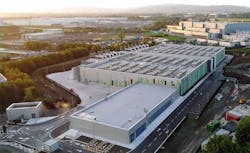The Network Effect of Global Data Centers
Metcalfe's Law, stipulating that the value of a telecommunications network is proportional to the square of the number of nodes connected to the system, was primarily created as a tool for salespeople selling ethernet systems to enterprises in the 1980s. It was modified slightly to replace 'nodes' with 'users' in the 1990s and gradually morphed into what today is referred to as "the network effect," a concept applied to technology, finance, social networks, software, cloud services, Web3 services, and more. Effectively, it says that for these services to survive and grow, they need to achieve adoption rates that make them more worthwhile for new users to join or use the services.
Often, the network effect is applied to a single product or company. But it can also apply to an industry that provides a service through multiple providers to a fast-growing audience of customers and end users.
Today, the network effect can be seen in the data center industry as its markets expand around the world. Data centers anchor the digital infrastructure that enables greater global connectivity, generates more powerful and proximate computing, and empowers local customers everywhere to participate directly in the digital economy.
The value of a global data center platform is not measured simply in gigawatts or square meters. In fact, it is probably best measured against the industries, enterprises, and service providers who rely on it to provide power, capacity, proximity, and connectivity, and by the benefits the platform provides to end users. This may mean some of the facilities that populate the platform are small, hyperlocal data centers serving specific use cases while others are hyperscale sites serving the largest companies in the world. But taken together, these disparate deployments add up to one of the most important – and valuable – networks ever created.
The key is providing data center customers with the services, scale, reach, and flexibility they need. Because as with almost any business or industry, customer experience goes a long way in determining how enthusiastically new customers will join and how long existing customers will stick around. As Forrester Research has noted, "Companies will win or lose based on experience, and CX [customer experience] is still the vital point of differentiation and growth."
Flexibility may be the biggest customer experience differentiator for a global data center platform. Are you building data centers where it is most convenient for the data center provider and telling customers they must go wherever you have chosen to build? Or do you listen to your customers, work closely with them to identify markets and properties, define the scale, and establish the timeline and budget that will get them what they need and where they need it when they need it?
Flexibility is also a baseline requirement for data center providers working with customers whose own businesses are pushing forward with technologies that need creative, adaptive data center solutions. Whether that means a data center with high-density power for Machine Learning or a smaller deployment to facilitate EV charging, data off-loads, and firmware and software updates for a new generation of cars, trucks, and other vehicles. But for data center customers, there is another level of flexibility they need to achieve – the end user experience of their own customers.
A global data center platform – built to help data center customers deliver better service to their own customers in any market anywhere in the world – ultimately facilitates a better end user experience. The platform's data centers are located in markets that will help minimize latency. They are built using stronger, faster, more economical construction techniques. They operate more efficiently. And they meet the unique power, space, cooling, and security needs of the businesses inside the data center. But for the end user, the user experience benefits are more direct and concrete: faster performance, higher availability, greater mobility, lower costs, and access to more content, communications, services, and applications.
At EdgeConneX, we recently published an e-book that examines user experience (UX) as an area that data center customers should focus on so that their data center strategies align with their customers' expectations. The e-book offers this bottom-line message: You gain a competitive advantage by delivering the best user experience. You keep a competitive advantage by delivering the best user experience economically.
So, how does the network effect enter into this digital supply chain, extending from the data center platform to the services provider and end user? Well, as more businesses take advantage of the global platform, the more efficiently, extensively, and precisely it can be deployed and operated, making it even more valuable to more businesses as they grow. And those businesses see the corresponding network effect in their products and services as they become available to more users in more global markets, with correlated user experience improvements.
The world really is getting smaller, in no small part, due to the services provided by data centers around the globe. But none of us – data center providers, service providers, enterprises, innovators, or networks – can afford to neglect the experiences our end users have as they interact with our products, tools, and platforms.
Phillip Marangella is CMO of EdgeConneX, a global data center provider focused on driving innovation. Contact EdgeConneX to learn more about their data center design strategy.






